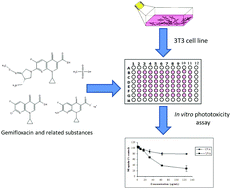Biological safety studies of gemifloxacin mesylate and related substances
Abstract
Purpose: The aim of this study was to evaluate the cytotoxic, phototoxic, genotoxic and photogenotoxic potential of

* Corresponding authors
a
Programa de Pós-Graduação em Ciências Farmacêuticas, Faculdade de Farmácia, Universidade Federal do Rio Grande do Sul (UFRGS), Avenida Ipiranga 2752/402, Porto Alegre-RS, Brazil
E-mail:
csoldatelli30@hotmail.com
Fax: +55 51 33085378
Tel: +55 51 33085214
b Departament de Fisiologia, Facultat de Farmàcia, Universitat de Barcelona, Av Joan XXIII s/n, Barcelona, Spain
c Unidad de Toxicologia y Ecotoxicologia del Parc Cientific de Barcelona, Baldiri Reixac 4, Barcelona, Spain
Purpose: The aim of this study was to evaluate the cytotoxic, phototoxic, genotoxic and photogenotoxic potential of

 Please wait while we load your content...
Something went wrong. Try again?
Please wait while we load your content...
Something went wrong. Try again?
C. S. Paim, D. R. Nogueira, M. Mitjans, D. Ramos Lopez, J. de Lapuente Perez, M. Steppe, E. E. S. Schapoval and M. P. Vinardell, Photochem. Photobiol. Sci., 2013, 12, 805 DOI: 10.1039/C3PP25369D
To request permission to reproduce material from this article, please go to the Copyright Clearance Center request page.
If you are an author contributing to an RSC publication, you do not need to request permission provided correct acknowledgement is given.
If you are the author of this article, you do not need to request permission to reproduce figures and diagrams provided correct acknowledgement is given. If you want to reproduce the whole article in a third-party publication (excluding your thesis/dissertation for which permission is not required) please go to the Copyright Clearance Center request page.
Read more about how to correctly acknowledge RSC content.
 Fetching data from CrossRef.
Fetching data from CrossRef.
This may take some time to load.
Loading related content
